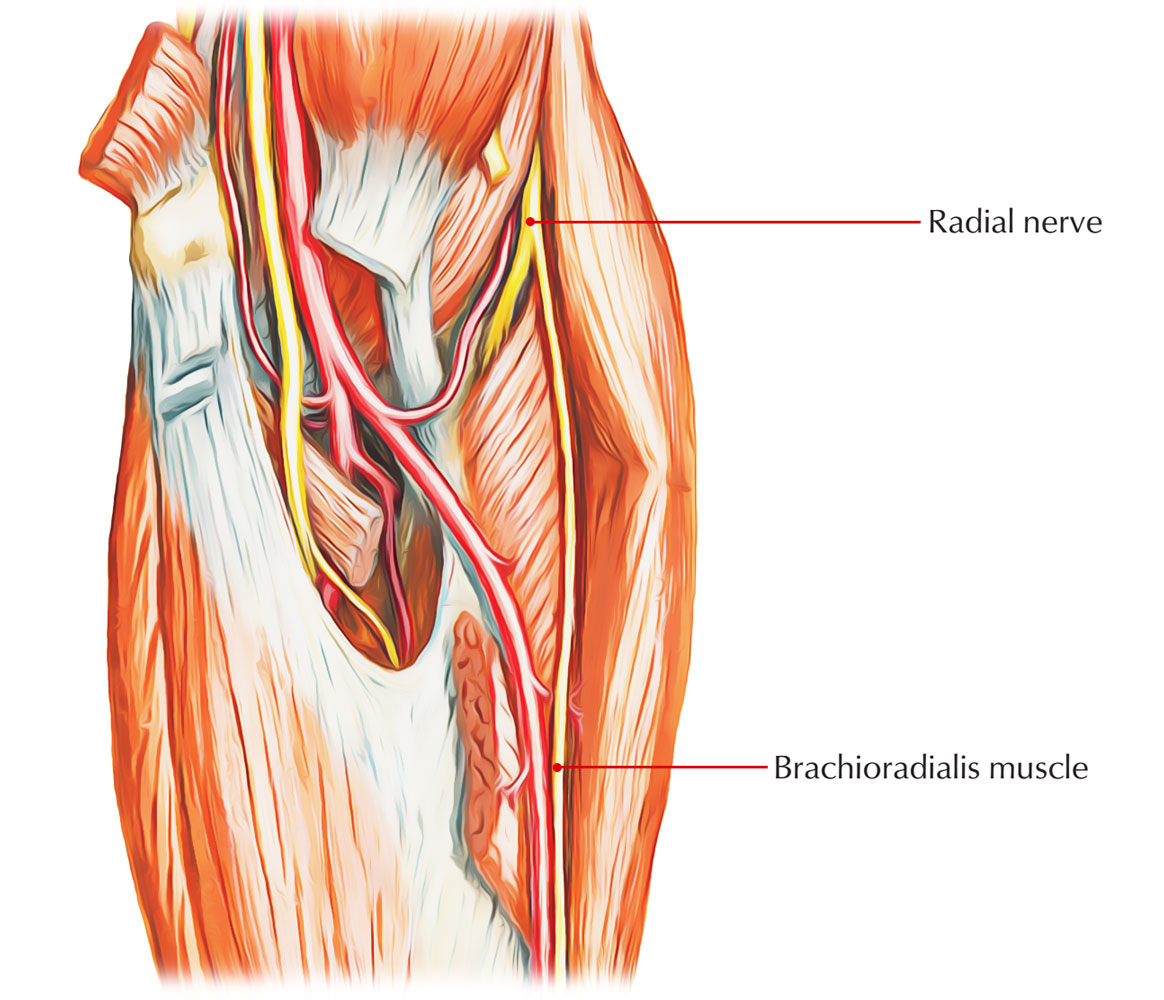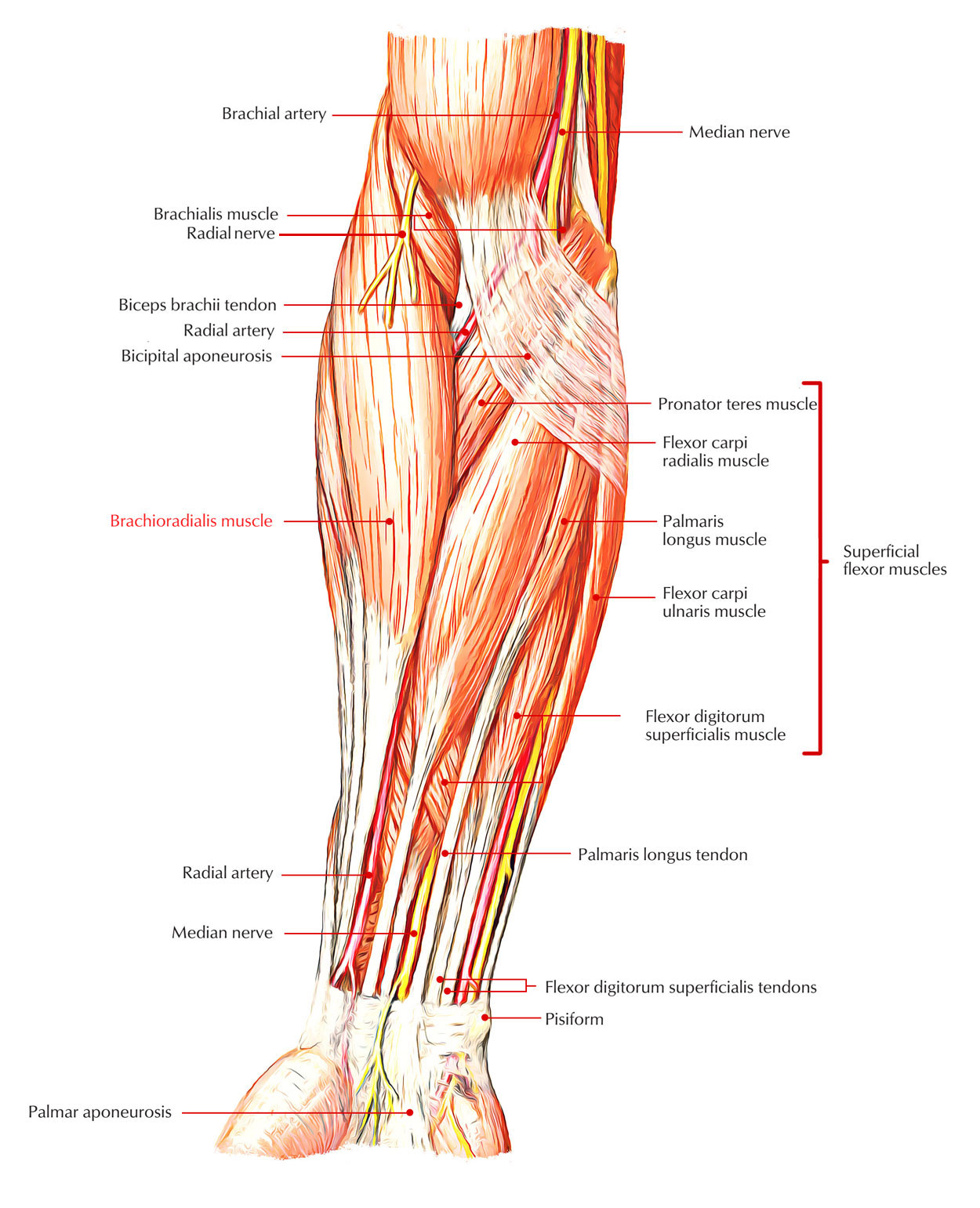The brachioradialis muscle travels through the forearm in order to attach on the lateral aspect of the distal end of the radius simply proximal towards the radial styloid process and emerges via the proximal portion of the supra-epicondylar rim of the humerus.

Brachioradialis
Brachioradialis
Insertion
The superior end of the brachioradialis originates near the attachment of the deltoid. Emerging two-thirds of the way into the humerus among the triceps as well as brachialis, the belly of the brachioradialis emerges wide and flat at its origination, turns towards the front of the arm as it goes down while getting rounder within cross section at the elbow, and broadens and straightens again prior to terminating within a flat tendon around one-half to two-thirds of the way down the forearm.
Compared to most of the long tendons of the forearm, the tendon of the bra-chioradialis does not traverse the wrist joint, but instead stops at the distal end of the radius. On the forearm, the belly makes a shift among the flexor as well as extensor muscle groups, partially running over the extensor carpi radialis longus on one aspect and the pronator teres along with flexor carpi radialis on the other. The tendon of the brachioradialis is located at the radius and generally is not visible. In more distal zones, the brachioradialis is located over the superficial section of the radial nerve and radial artery
Attachments
Lateral towards the cubital fossa, the brachioradialis is located above the radial nerve along with its division within deep and superficial sections.
- The brachioradialis, the extensor carpi radialis longus, together with the extensor carpi radialis brevis are often categorized with each other as the radial group of forearm muscles.
- The brachioradialis and extensor carpi radialis longus directly proximal towards the lateral epicondyle of the humerus, both connect to the lateral supracondylar rim of the humerus.
- The brachioradialis lies within the superficial layer of the anterior portion of the forearm (together with the pronator teres and the muscles of the wrist flexor group).
- The brachioradialis is occasionally called the hitchhiker muscle for the unique activity of flexing the forearm in a stance midway in between full pronation and full supination (along with the thumb up) when hitchhiking. The brachioradialis has no activity on the thumb itself.
Activities
Due to the fact that the brachioradialis is anterior towards the elbow joint, it serves as an additional flexor of this joint although it remains in the posterior compartment of the forearm. Its activity is most effective when the forearm is midpronated and it creates a protuberant bulge as it operates in opposition to resistance. In the anatomical position, the brachioradialis belongs to the muscle mass overlying the anterolateral side of the forearm and also creates the lateral boundary of the cubital fossa.
Standard Activity
If the forearm is completely supinated, the brachioradialis will pronate the forearm towards a position that is around halfway within full pronation and full supination since that stance will likely have the two connections of the brachioradialis, the styloid procedure of the radius as well as the lateral supracondylar rim of the humerus, as near one another as possible. In a similar way, if the forearm is completely pronated, the brachioradialis could supinate the forearm towards a position that is partially between full pronation and full supination for the same purpose.
The brachioradialis traverses the elbow joint anteriorly with its fibers travelling vertically within the sagittal plane, it flexes the forearm at the elbow joint.
The brachioradialis is most efficient being a forearm flexor whenever the forearm remains in a position which is midway among full pronation as well as full supination.
The brachioradialis is unique because it can both supinate and pronate the forearm at the Radioulnar joints.
Reverse Activity
Supination and pronation are usually considered having a moving radius act over a fixed ulna. Even so, if the hand is kept solidified (perhaps by keeping an immovable object), the radius will also be set for rotation activities as the wrist joint does not permit rotation. Hence the reverse activity of supination of the forearm at the Radioulnar joints consists of a mobile ulna supinating over a fixed radius.
If the forearm is fixed, the brachioradialis draws the anterior side of the arm toward the anterior side of the forearm. This activity is flexion of the arm at the elbow joint. The reverse activity of flexion of the arm at the elbow joint is extremely crucial and takes place each time a person grips a stable object and draws his or her body toward it.
Nerve Supply

Nerve Supply of Brachioradialis
The brachioradialis is a flexor of the forearm over at the elbow joint, but it is supplied by the radial nerve, which stimulates all of the forearm extensors.


 (60 votes, average: 4.70 out of 5)
(60 votes, average: 4.70 out of 5)